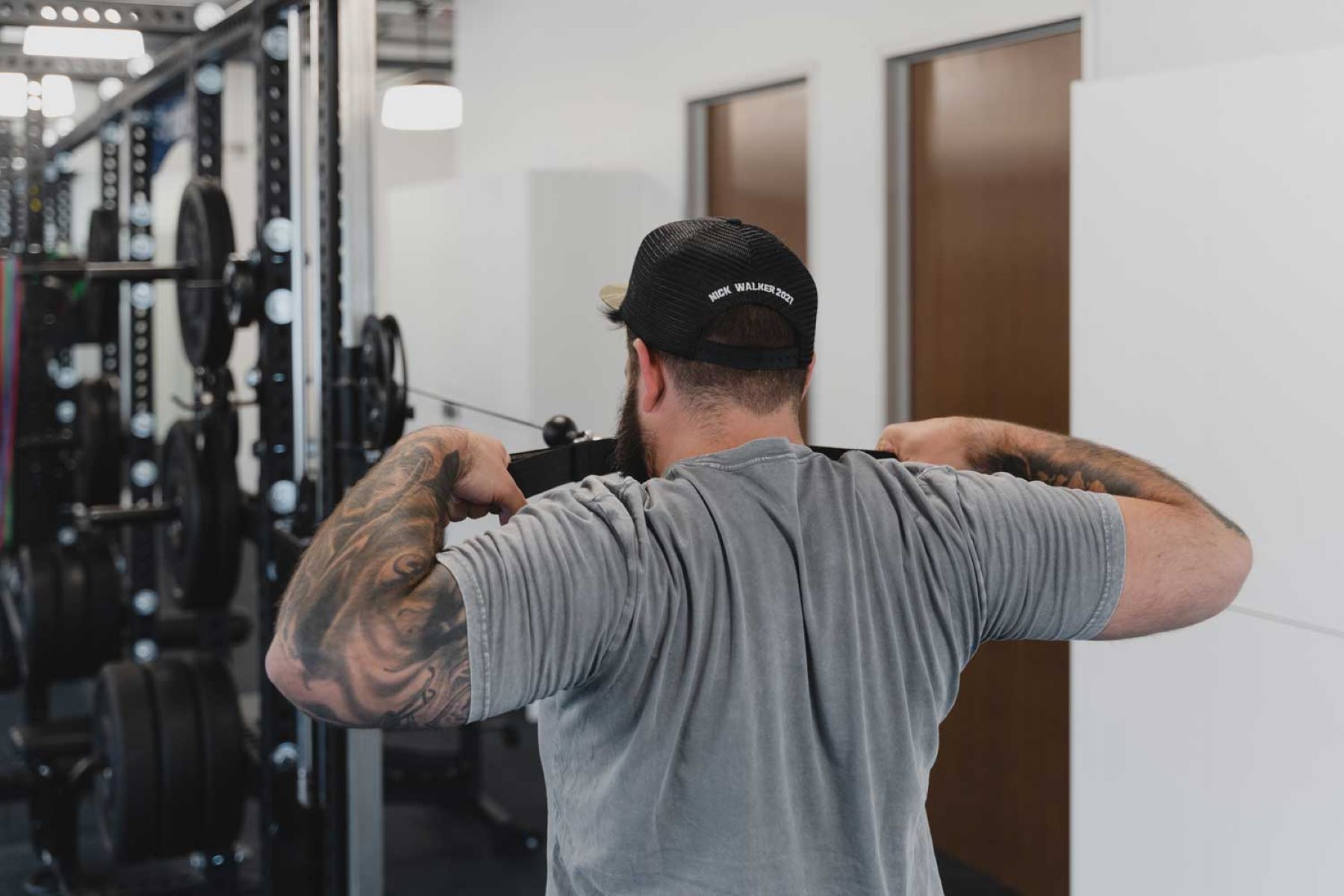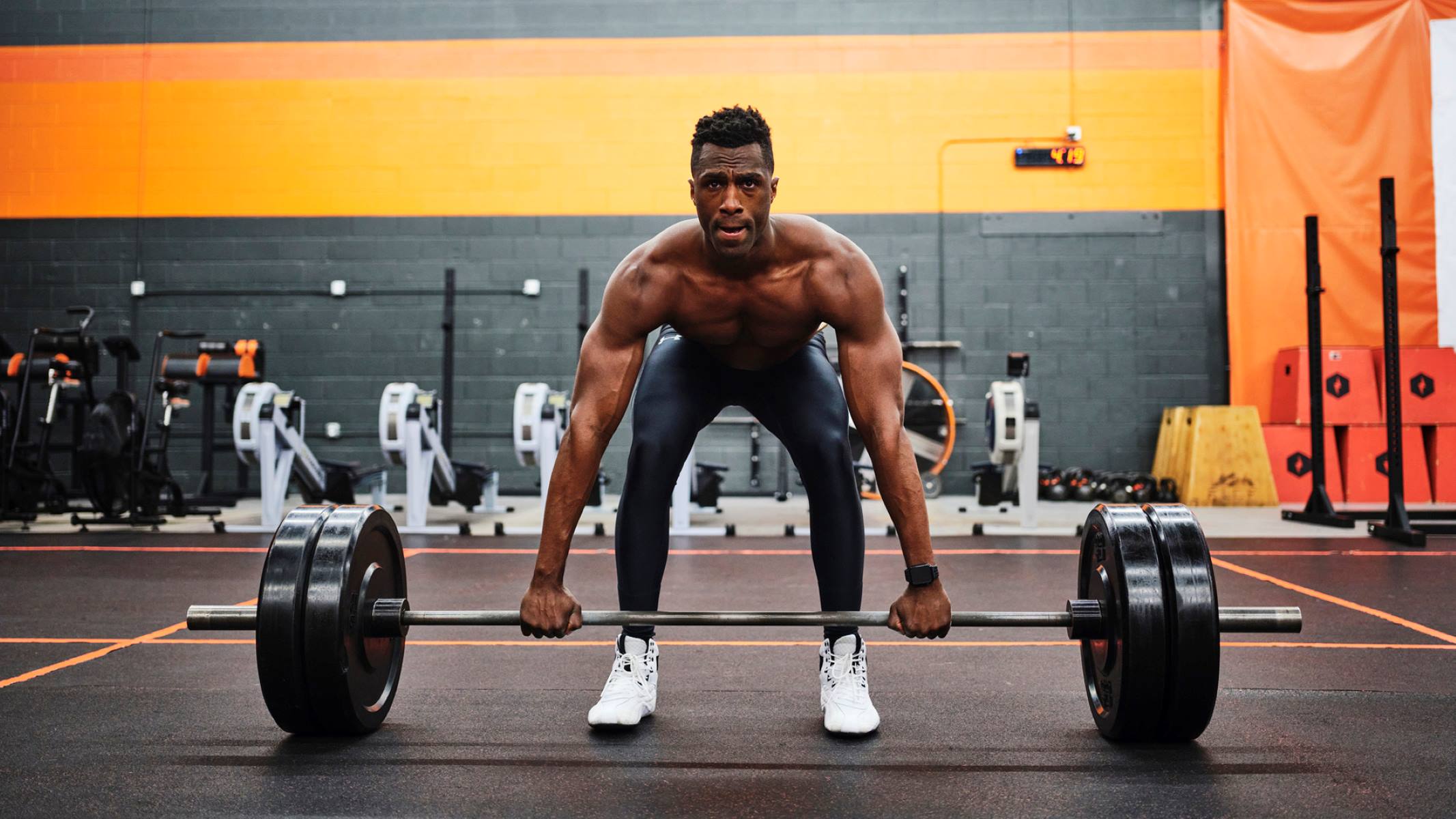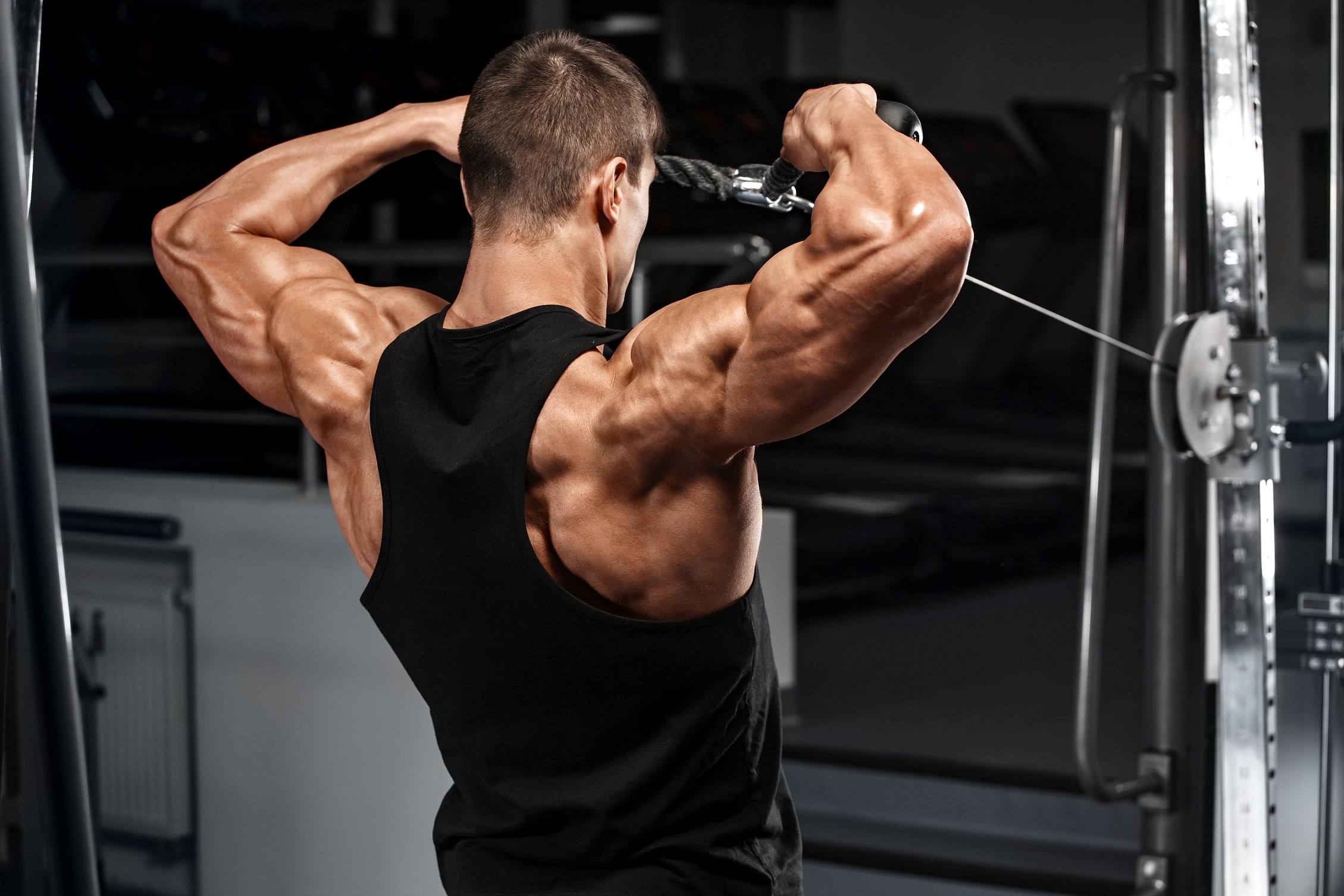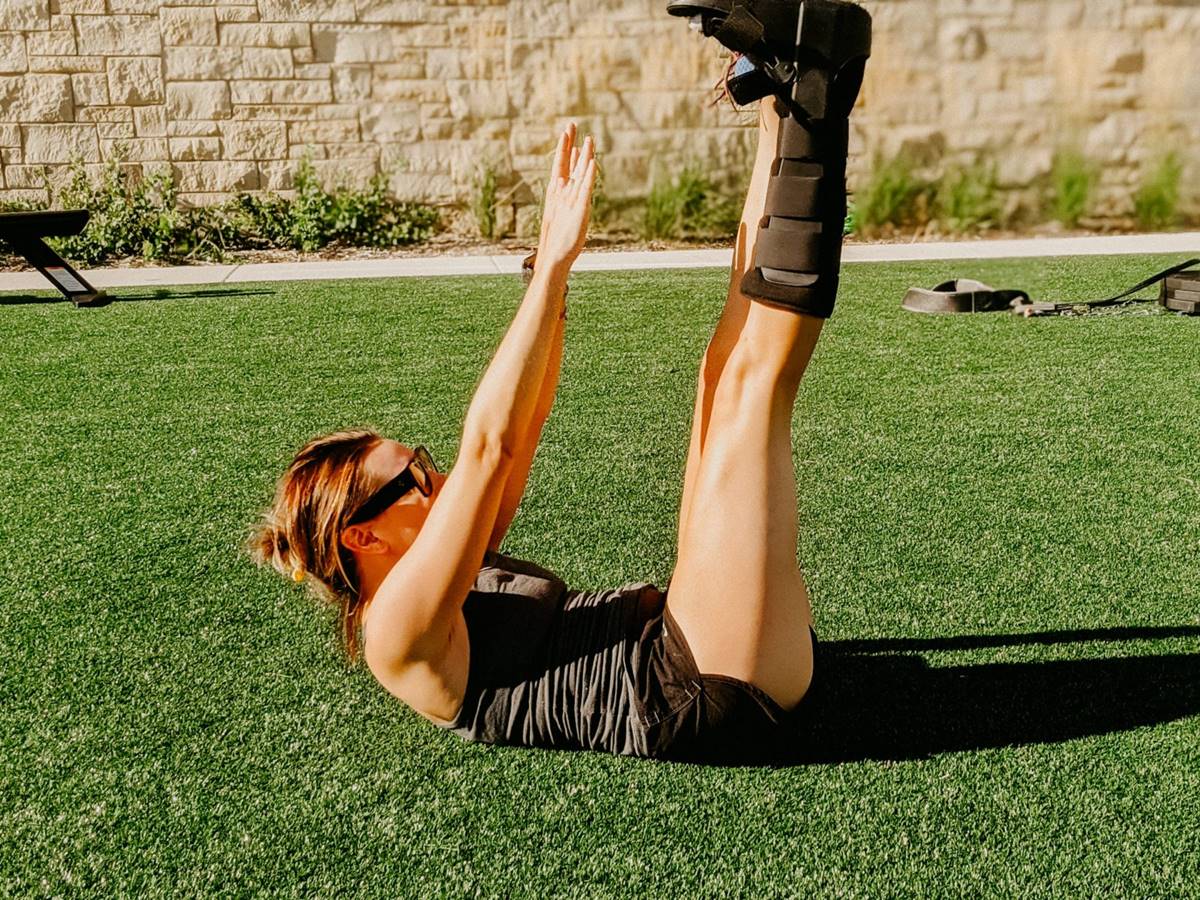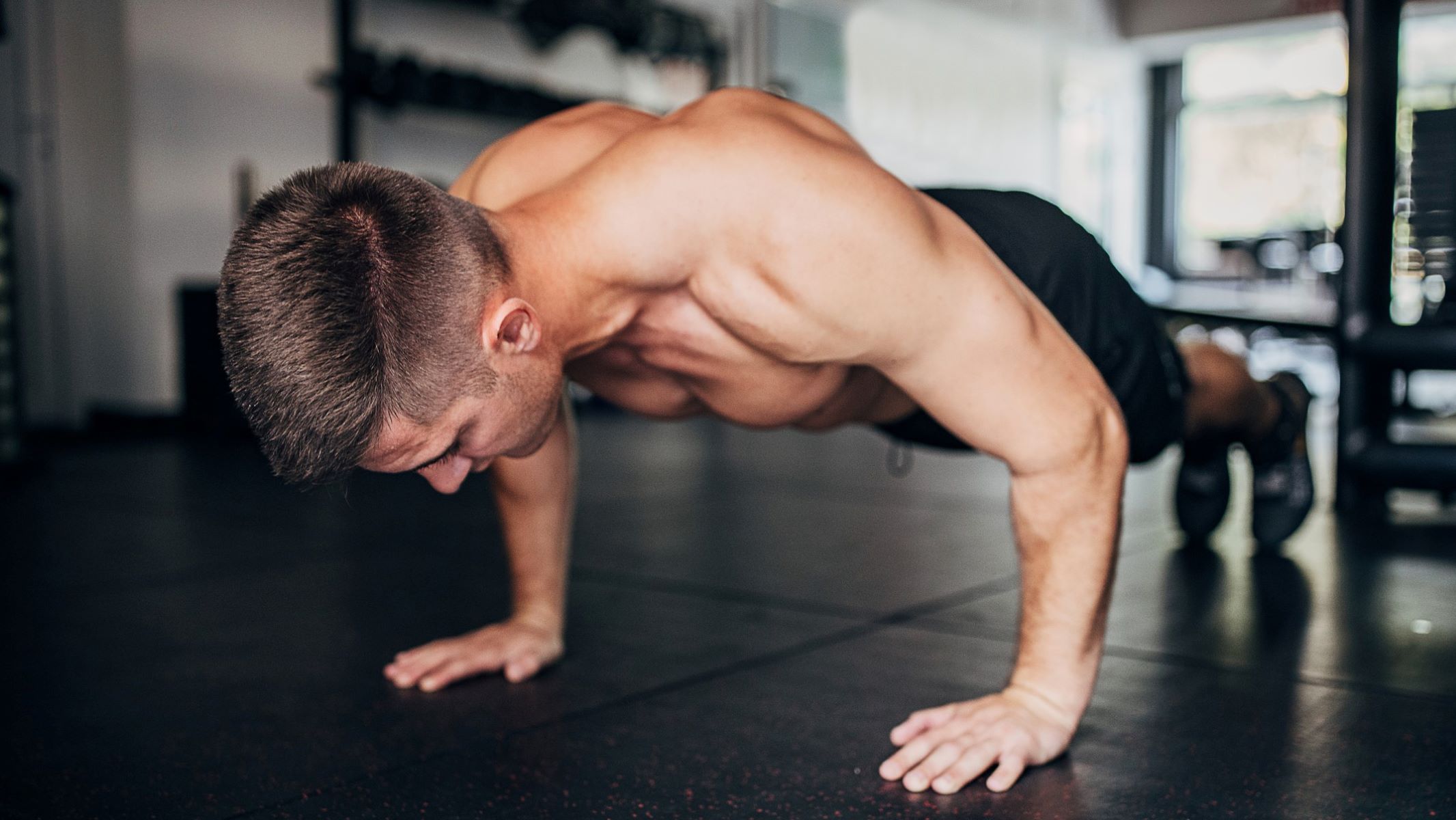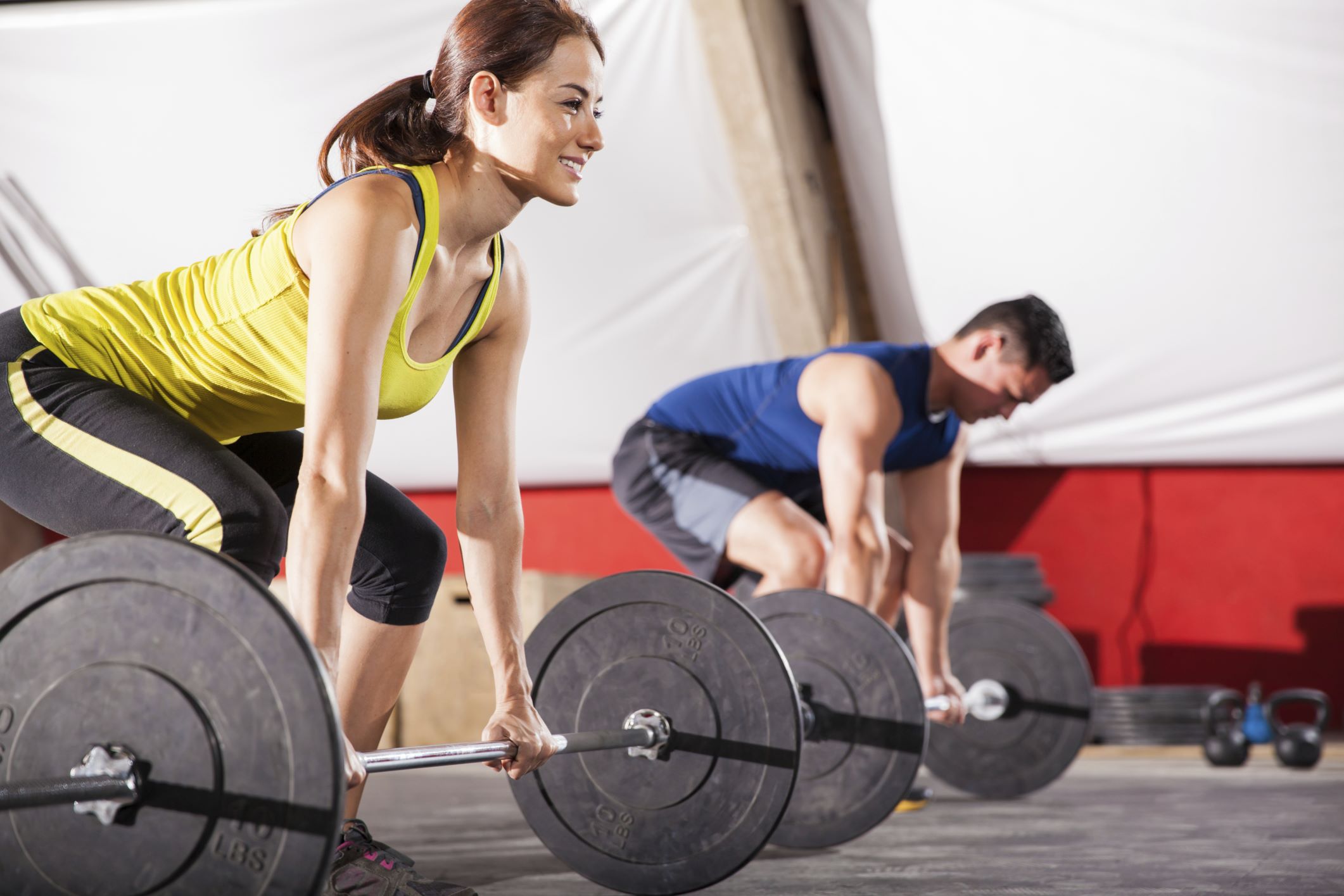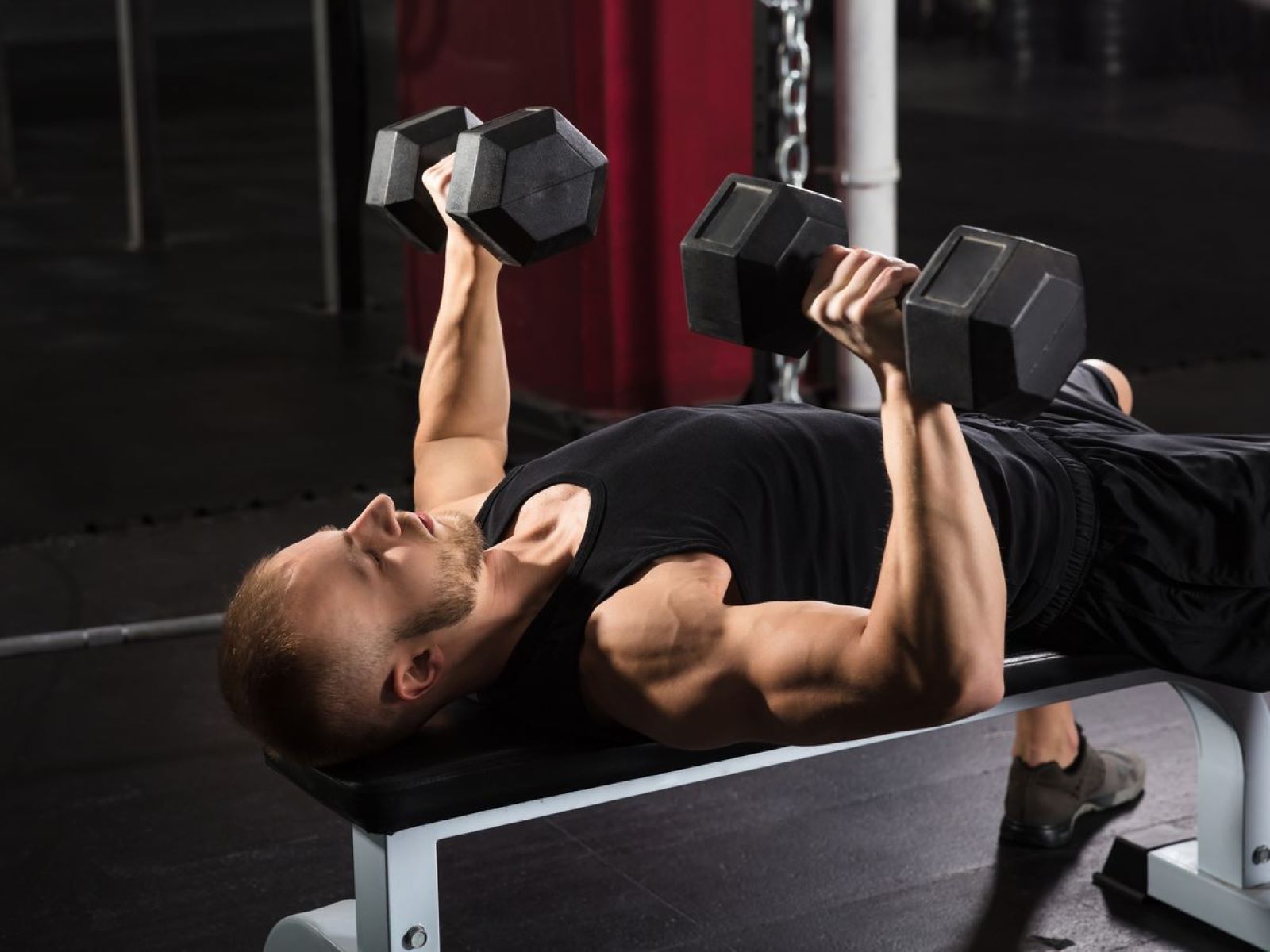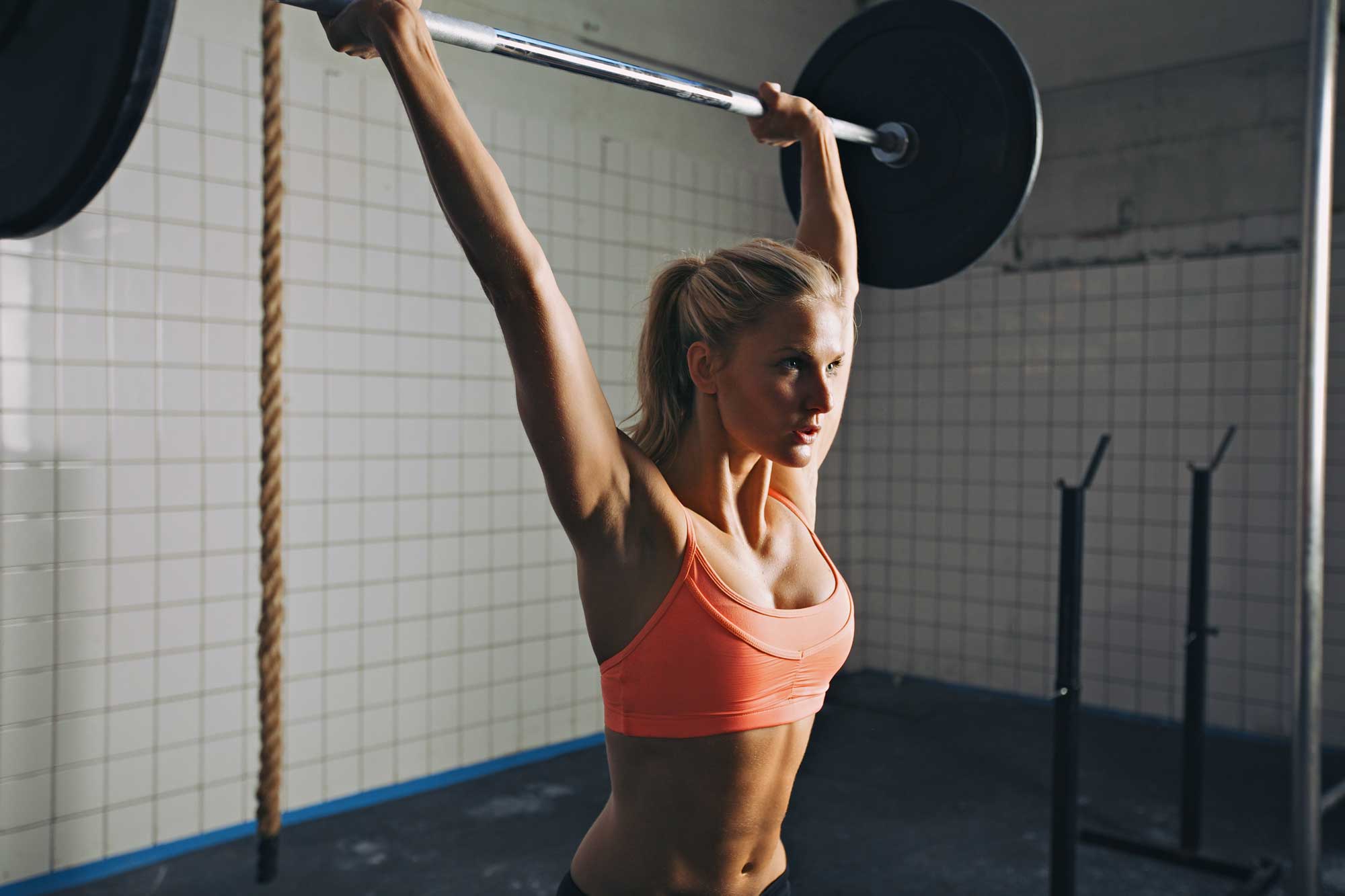

Featured
What Does Overhead Press Workout
Modified: March 1, 2024
Discover the benefits of the overhead press workout and how it can transform your upper body strength. Get featured in your fitness journey today!
Introduction
The overhead press, also known as the shoulder press or military press, is a compound exercise that primarily targets the muscles of the shoulders, but also engages the muscles of the upper back, arms, and core. It involves pressing a weight overhead from a standing position, making it an effective exercise for building upper body strength and stability.
Unlike other shoulder exercises that primarily focus on the anterior deltoids, the overhead press targets all three heads of the shoulder muscles – the anterior, medial, and posterior deltoids. Additionally, it engages the trapezius, triceps, and core muscles to stabilize the body during the movement.
The overhead press offers a multitude of benefits, making it an essential exercise for anyone looking to improve their overall strength and physique. In this article, we will explore the various benefits of the overhead press, the muscles targeted, proper form and technique, different variations, common mistakes to avoid, safety tips, and even provide a sample workout routine to help you incorporate the overhead press into your fitness routine.
Benefits of Overhead Press Workout
The overhead press workout offers a wide range of benefits that make it a valuable exercise for both strength training enthusiasts and athletes alike. Here are some of the key benefits:
- Increased Shoulder Strength: The overhead press primarily targets the shoulder muscles, helping to build strength and size in the deltoids. This can enhance shoulder stability and improve performance in activities that involve pushing or lifting overhead.
- Improved Upper Body Strength: In addition to the shoulders, the overhead press also engages the muscles of the upper back, arms, and core. This compound movement activates multiple muscle groups, leading to overall upper body strength development.
- Enhanced Muscle Definition: By engaging the muscles of the shoulders, upper back, and arms, the overhead press can contribute to a more defined and sculpted upper body. This can be especially beneficial for those looking to improve their aesthetic appearance.
- Functional Strength: The overhead press mimics many real-life movements that involve pushing or lifting objects overhead. By training with this exercise, you can develop functional strength that translates into improved performance in various daily activities or sports.
- Core Stability: The overhead press requires core activation to maintain stability and prevent excessive arching of the lower back. This can help develop a strong and stable core, which is essential for overall strength and injury prevention.
- Improved Posture: Strengthening the muscles of the upper body, including the shoulders and upper back, can contribute to better posture. The overhead press can help counteract the effects of poor posture and promote a more upright and balanced stance.
- Increased Bone Density: Weight-bearing exercises, such as the overhead press, can help improve bone density and reduce the risk of osteoporosis. This is particularly important for older adults who are prone to age-related bone loss.
- Boosted Metabolism: The overhead press is a compound exercise that engages multiple muscle groups simultaneously. This can lead to an increased metabolic rate, allowing you to burn more calories and fat both during and after your workout.
- Enhanced Overall Fitness: Incorporating the overhead press into your workout routine can contribute to overall improvements in strength, muscle endurance, power, and athletic performance.
As you can see, the overhead press provides a wide range of benefits, making it a valuable exercise for individuals of all fitness levels and goals. Whether you’re a seasoned lifter looking to build strength or a beginner looking to improve your overall fitness, including the overhead press in your routine can help you achieve your desired results.
Muscles Targeted
The overhead press is a compound exercise that targets several major muscle groups in the upper body. By understanding which muscles are involved, you can better appreciate the benefits and effectiveness of this exercise. Here are the main muscles targeted during the overhead press:
- Deltoids: The deltoid muscles, located on the shoulders, are the primary muscles targeted during the overhead press. They consist of three heads: the anterior deltoid, medial deltoid, and posterior deltoid. The anterior deltoid helps with the initial lift, while the medial deltoid contributes to the middle phase of the movement. The posterior deltoid assists in the final phase, particularly during the lowering of the weight.
- Trapezius: The trapezius muscles, commonly referred to as the traps, run along the upper back and play a significant role in stabilizing the shoulder blades during the overhead press. They also assist in the initial lift and help maintain proper posture throughout the movement.
- Triceps: The triceps brachii, located on the back of the upper arms, act as synergists during the overhead press. They assist the deltoids in extending and straightening the arms, especially during the upward phase of the lift.
- Upper Chest (Clavicular Pectoralis Major): Though not the primary target, the clavicular portion of the pectoralis major, commonly known as the upper chest, is also engaged during the overhead press. It assists the anterior deltoids in the initial phase of the movement.
- Core Muscles: The core muscles, including the abdominals, obliques, and lower back muscles, play a crucial role in stabilizing the body during the overhead press. They help maintain proper posture, prevent excessive arching or leaning, and transfer force from the lower body to the upper body.
- Forearm Muscles: The muscles of the forearms, including the brachioradialis and forearm flexors, are engaged to stabilize the wrists and maintain a secure grip on the weight during the overhead press.
By targeting these muscle groups, the overhead press workout provides a comprehensive upper body workout, promoting strength, stability, and muscle development. It is important to note that the level of muscle activation may vary depending on individual biomechanics and technique.
Proper Form and Technique
Performing the overhead press with proper form and technique is crucial for maximizing its effectiveness and reducing the risk of injury. Follow these steps to ensure proper form:
- Starting Position: Stand with your feet shoulder-width apart, knees slightly bent. Hold the barbell or dumbbells at shoulder level, palms facing forward. Engage your core and maintain a neutral spine.
- Execution: Press the weight overhead by extending your arms, keeping your elbows slightly in front of the barbell or dumbbells. As you lift, avoid arching your lower back or allowing your shoulders to shrug. Maintain a strong and stable core throughout the movement.
- Lockout: Fully extend your arms overhead, locking out your elbows without hyperextending them. At the top position, your biceps should be close to your ears and your core should be engaged.
- Lowering: Lower the weight back down to shoulder level in a controlled manner, avoiding any sudden or jerky movements. Keep your core tight and maintain good posture throughout the lowering phase.
- Breathing: Inhale as you lower the weight and exhale as you press it overhead. Focus on maintaining consistent and controlled breathing throughout the exercise.
- Range of Motion: Aim to lower the weight until your upper arms are parallel to the floor or slightly below. This ensures a full range of motion and engages the muscles effectively. Avoid locking your joints at the bottom position.
- Hand Grip: Choose a grip width that feels comfortable for you, typically slightly wider than shoulder-width apart. For barbell overhead press, you can use a pronated (palms facing forward) or mixed grip. For dumbbell overhead press, grip the dumbbells with an overhand grip, palms facing forward.
- Progression: Start with lighter weights and gradually increase the load as you become more comfortable and confident with the movement. Avoid sacrificing form for heavier weights.
- Posture and Alignment: Maintain proper posture throughout the exercise. Keep your chest lifted, shoulders back and down, and neck in a neutral position. Avoid excessive leaning, arching of the lower back, or shrugging of the shoulders.
It’s important to note that the overhead press can be performed with various equipment, such as barbells, dumbbells, kettlebells, or even resistance bands. Choose the equipment that suits your fitness level and preference, and ensure proper form and technique regardless of the equipment used.
If you’re new to the overhead press or unsure about your form, consider working with a certified personal trainer or strength coach to ensure proper execution and prevent any potential injuries.
Variations of the Overhead Press
The overhead press can be modified and performed in different variations to add variety to your training routine and target specific muscle groups. Here are some common variations of the overhead press:
- Barbell Overhead Press: This is the classic version of the overhead press, performed with a barbell. It allows you to lift heavier weights and engage multiple muscle groups simultaneously.
- Dumbbell Overhead Press: Similar to the barbell overhead press, but using dumbbells instead. This variation helps improve muscular imbalances and allows for more freedom of movement.
- Kettlebell Overhead Press: Performed with kettlebells, this variation adds an extra challenge to the exercise due to the unstable nature of the kettlebells. It requires increased core stabilization and grip strength.
- Single-Arm Overhead Press: Instead of using both arms simultaneously, this variation focuses on one arm at a time. It helps improve unilateral strength and stability while addressing muscular imbalances.
- Push Press: Incorporating a slight leg drive, the push press allows you to use more power and generate more force to press the weight overhead. It primarily targets the shoulders but also engages the legs and core.
- Seated Overhead Press: Performed while seated on a bench or chair, this variation removes the lower body from the movement. It isolates the shoulders and minimizes the use of momentum, placing more emphasis on the deltoids.
- Behind-the-Neck Press: In this variation, the barbell is lowered behind the head instead of in front of it. It places greater emphasis on the medial and posterior deltoids but requires extra mobility and caution to avoid shoulder strain.
- Arnold Press: Pioneered by bodybuilder and movie star Arnold Schwarzenegger, this variation involves rotating the palms as you press the dumbbells overhead. It targets all three heads of the deltoids and adds an extra challenge to the movement.
- Z Press: A challenging variation that is performed while seated on the floor with your legs extended straight in front of you. It requires a strong core and shoulder mobility, as you press the weight while seated in an upright position.
- Resistance Band Overhead Press: This variation involves using resistance bands to perform the overhead press. It provides constant tension throughout the movement and can be a great option for those without access to weights or looking for a portable workout option.
These variations offer different benefits and target specific muscle groups or training goals. Incorporating a variety of overhead press variations into your training routine can help prevent plateauing, stimulate muscle growth, and add excitement to your workouts. Choose the variation that suits your fitness level, equipment availability, and specific training objectives.
Common Mistakes to Avoid
While the overhead press is an effective exercise, it’s important to be aware of common mistakes that can compromise your form and hinder your progress. By avoiding these mistakes, you can maximize the benefits and reduce the risk of injuries. Here are some common mistakes to watch out for:
- Arching the Lower Back: One of the most common mistakes is excessive arching of the lower back during the overhead press. This can lead to strain or injury. Maintain a neutral spine throughout the movement, engaging your core and avoiding any excessive arching or leaning.
- Using Too Much Weight: Trying to lift more weight than you can handle can compromise your form and increase the risk of injury. Start with a weight that allows you to maintain proper form and gradually progress as your strength improves.
- Shrugging the Shoulders: It’s important to keep your shoulders down and avoid shrugging them towards your ears during the movement. Shrugging can lead to unnecessary tension in the neck and prevent proper activation of the deltoid muscles.
- Leaning Back: Leaning back excessively while pressing the weight overhead may give you a false sense of strength but can strain the lower back and compromise form. Maintain an upright posture throughout the exercise.
- Locking the Elbows: Locking out the elbows at the top position of the overhead press can place unnecessary stress on the joint. Avoid hyperextending the elbows and maintain a slight bend to protect your joints.
- Failing to Engage the Core: Neglecting to engage the core can lead to decreased stability and compromise your form. Properly activate your core muscles to maintain a stable and strong center throughout the movement.
- Inconsistent Breathing: Breathing plays a crucial role in maintaining stability and proper form. Inhale as you lower the weight and exhale as you press it overhead. Avoid holding your breath or breathing too quickly.
- Moving the Head Forward: Pushing the head forward instead of keeping it in alignment with the spine can strain the neck and lead to poor posture. Keep your head in a neutral position throughout the exercise.
- Improper Grip Placement: Placing your hands too wide or too narrow on the barbell or dumbbells can compromise your form and limit your range of motion. Choose a grip width that allows for proper alignment of the wrists, elbows, and shoulders.
- Neglecting Warm-Up and Mobility: Skipping a proper warm-up and neglecting mobility exercises can increase the risk of injury and limit your range of motion. Prepare your body with dynamic stretches and mobility drills before starting your overhead press workout.
Avoiding these common mistakes will help you perform the overhead press with proper form, reduce the risk of injury, and maximize the effectiveness of the exercise. If you are unsure about your technique, consider seeking guidance from a qualified fitness professional or strength coach.
Safety Tips
While the overhead press can provide numerous benefits when performed correctly, it is important to prioritize safety to prevent injuries. Here are some safety tips to keep in mind when performing the overhead press:
- Start with Proper Warm-Up: Begin your workout with a thorough warm-up that includes dynamic stretches and mobility exercises for the shoulders, upper back, and core. This helps prepare your muscles and joints for the overhead press and reduces the risk of strain or injury.
- Use Appropriate Weight: Choose a weight that challenges you but still allows you to maintain proper form. Avoid using weights that are too heavy and compromise your technique or strain your muscles and joints.
- Maintain Proper Form: Focus on maintaining good posture throughout the exercise. Keep your core engaged, avoid excessive arching of the lower back, and refrain from using excessive momentum or cheating techniques.
- Progress Gradually: Increase the weight and intensity of your overhead press gradually over time. Rushing to lift heavy weights that your muscles and joints are not prepared for can increase the risk of injury.
- Pay Attention to Your Breathing: Proper breathing is essential for maintaining stability and controlling the movement. Inhale during the eccentric phase (lowering) and exhale during the concentric phase (pressing) of the exercise.
- Don’t Sacrifice Form for Repetitions: Focus on quality over quantity. Avoid sacrificing your form to complete more repetitions. It is better to perform fewer repetitions with proper form than to perform more with compromised technique.
- Incorporate Rest Days: Allow your muscles to recover and adapt by incorporating rest days into your training routine. Overtraining can increase the risk of overuse injuries and hinder your progress.
- Listen to Your Body: Pay attention to any pain or discomfort during the overhead press. If you experience sharp or persistent pain, stop the exercise and consult with a healthcare professional or qualified fitness expert.
- Seek Professional Guidance: If you are new to the overhead press or unsure about your technique, consider working with a certified personal trainer or strength coach. They can provide guidance, correct any form mistakes, and ensure your safety during the exercise.
- Modify as Necessary: If you have any pre-existing shoulder or back injuries or limitations, consult with a healthcare professional or knowledgeable fitness expert to modify the exercise to suit your needs and abilities.
Prioritizing safety throughout your overhead press workouts is essential for long-term progress and injury prevention. By following these safety tips, you can perform the exercise with confidence and reap the full benefits of this effective upper body strength-building movement.
Sample Overhead Press Workout Routine
If you’re looking to incorporate the overhead press into your fitness routine, here’s a sample workout that targets the shoulders, upper back, and arms:
Exercise: Overhead Press
Sets: 3-4
Reps: 8-12
Rest: 60-90 seconds between sets
Warm-Up:
Start with 5-10 minutes of light cardio, such as jogging or cycling, to raise your heart rate and warm up your muscles. Follow it up with some dynamic shoulder stretches and mobility exercises to prepare your shoulders for the overhead press.
Workout:
- Barbell Overhead Press: 3-4 sets of 8-12 reps with a challenging but manageable weight. Focus on maintaining proper form throughout the exercise. Rest for 60-90 seconds between sets.
- Superset: Dumbbell Arnold Press and Lateral Raises: Perform 3 sets of 10-12 reps each exercise. Start with the Arnold Press by rotating your palms as you press the dumbbells overhead, then immediately transition into lateral raises to target the medial deltoids. Rest for 60-90 seconds between supersets.
- Seated Dumbbell Shoulder Press: 3 sets of 10-12 reps. Sit on a bench with your back supported and press the dumbbells overhead, focusing on a controlled movement and maintaining proper form. Rest for 60-90 seconds between sets.
- Standing Barbell Upright Rows: 3 sets of 10-12 reps. Hold a barbell with an overhand grip, standing with your feet shoulder-width apart. Lift the barbell to chest height, leading with your elbows and keeping them slightly higher than your wrists. Rest for 60-90 seconds between sets.
- Superset: Dumbbell Front Raises and Rear Delt Flyes: Perform 3 sets of 10-12 reps each exercise. Start with dumbbell front raises to target the anterior deltoids, then immediately transition into rear delt flyes to target the posterior deltoids. Rest for 60-90 seconds between supersets.
Cool-Down:
After completing the overhead press workout, take a few minutes to stretch your shoulder, upper back, and arm muscles. Focus on gentle stretches that help restore flexibility and promote recovery.
This sample overhead press workout routine provides a balanced approach to targeting the muscles of the shoulders, upper back, and arms. Adjust the weight and repetitions based on your fitness level and gradually increase the intensity as you become stronger and more comfortable with the movements. Remember to prioritize proper form and listen to your body throughout the workout.
Conclusion
The overhead press is a highly effective exercise for building shoulder strength, improving upper body definition, and enhancing overall fitness. By targeting the deltoids, trapezius, triceps, and core muscles, it offers a wide range of benefits that make it a valuable addition to any workout routine.
In this article, we have discussed the benefits of the overhead press, including increased shoulder strength, improved upper body strength and muscle definition, enhanced functional strength, core stability, improved posture, increased bone density, boosted metabolism, and enhanced overall fitness.
We have also highlighted the muscles targeted during the overhead press, emphasizing the deltoids, trapezius, triceps, upper chest, core muscles, and forearm muscles. Understanding these muscle groups helps you appreciate the efficiency of the movement and its impact on your overall physique.
Proper form and technique are essential for safely and effectively performing the overhead press. By maintaining a neutral spine, engaging the core, and following the recommended range of motion, you can maximize muscle activation and minimize the risk of injury.
Additionally, we explored various variations of the overhead press, such as the barbell press, dumbbell press, seated press, and push press. These variations provide diversity to your workouts, target specific muscle groups, and accommodate different fitness levels and equipment availability.
We also discussed common mistakes to avoid, such as arching the lower back, using too much weight, shrugging the shoulders, and neglecting core engagement. By being mindful of these mistakes, you can maintain proper form and get the most out of your overhead press workouts.
Lastly, we provided a sample overhead press workout routine that incorporates the exercise in a well-rounded upper body workout. This routine allows for progression, rest, and versatility, helping you achieve your strength and fitness goals.
In conclusion, the overhead press is a highly beneficial exercise that can boost your shoulder strength, enhance your upper body aesthetics, and improve functional strength. By incorporating this compound movement into your routine, prioritizing proper form, and gradually increasing the intensity, you can experience the many advantages it has to offer in your fitness journey.
